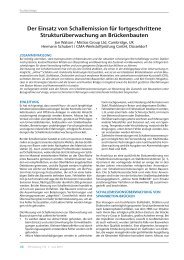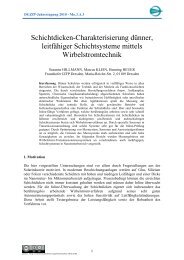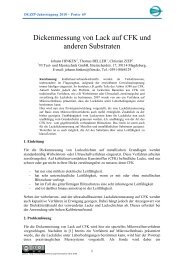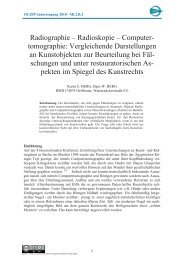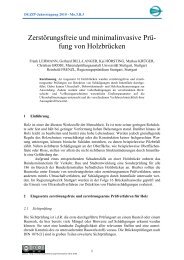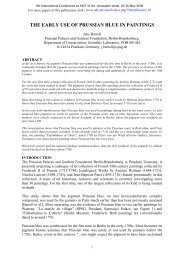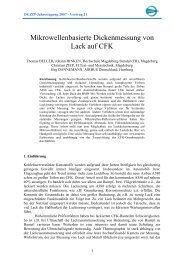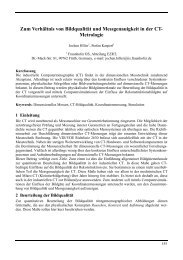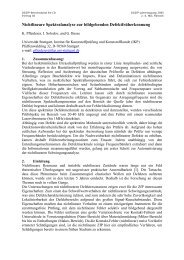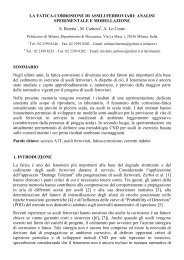Detection of Enclosed Diamonds using Dual Energy X-ray ... - NDT.net
Detection of Enclosed Diamonds using Dual Energy X-ray ... - NDT.net
Detection of Enclosed Diamonds using Dual Energy X-ray ... - NDT.net
Create successful ePaper yourself
Turn your PDF publications into a flip-book with our unique Google optimized e-Paper software.
18th World Conference on Nondestructive Testing, 16-20 April 2012, Durban, South Africa<br />
<strong>Detection</strong> <strong>of</strong> <strong>Enclosed</strong> <strong>Diamonds</strong> <strong>using</strong> <strong>Dual</strong> <strong>Energy</strong> X-<strong>ray</strong> imaging<br />
Markus FIRSCHING 1 , Frank NACHTRAB 1 , Jörg MÜHLBAUER 1 , Norman UHLMANN 1<br />
1 Fraunh<strong>of</strong>er IIS/EZRT Development Center X-Ray Technology, Dr.-Mack-Str. 81, 90762 Fürth, Germany<br />
Phone: +49 911 58061 7500, Fax: +49 911 58061 7599, email: markus.firsching@iis.fraunh<strong>of</strong>er.de<br />
Abstract<br />
<strong>Dual</strong> <strong>Energy</strong> techniques are well-known methods in X-<strong>ray</strong> imaging; however they are not commonly used in<br />
<strong>NDT</strong> or sorting. One <strong>of</strong> these techniques, Basis Material Decomposition (BMD) allows the determination <strong>of</strong> the<br />
fraction <strong>of</strong> mass <strong>of</strong> different (previously known) materials <strong>using</strong> two X-<strong>ray</strong> spectra and/or spectral detector<br />
efficiencies. The method exploits the dependence <strong>of</strong> the attenuation on energy <strong>of</strong> the X-<strong>ray</strong>s, mass density and<br />
atomic number.<br />
In diamond sorting, usually methods based on X-<strong>ray</strong> induced fluorescence are used, which does not work for<br />
encapsulated diamonds. Furthermore diamonds show very low contrast against their host ore kimberlite in<br />
conventional X-<strong>ray</strong> imaging, making it virtually impossible to detect them before the next crushing stage. BMD<br />
allows determining the fraction <strong>of</strong> mass <strong>of</strong> carbon and kimberlite both in radioscopic geometry (projective<br />
imaging, 2D) and X-<strong>ray</strong> computed tomography (3D). We present synthetic setups to evaluate the method as well<br />
as real examples to demonstrate the benefits this approach can provide.<br />
Keywords: diamond sorting, X-<strong>ray</strong>, dual energy, basis material decomposition<br />
1. Introduction<br />
In diamond mining, diamonds enclosed in the host material kimberlite cannot be detected by<br />
conventional X-<strong>ray</strong> fluorescence methods. Therefore the largest and most valuable diamonds<br />
are <strong>of</strong>ten passed to the next crushing stage. As diamonds show very low contrast against<br />
kimberlite, it is also hardly possible to detect them by means <strong>of</strong> standard radiographic<br />
imaging. However X-<strong>ray</strong> dual energy imaging can provide information on atomic number and<br />
mass density, both <strong>of</strong> which are different for kimberlite and diamond.<br />
2. <strong>Dual</strong> <strong>Energy</strong> X-<strong>ray</strong> imaging<br />
While it seems possible to distinguish different materials by their X-<strong>ray</strong> attenuation, these are<br />
only special cases. Generally it is not possible, especially if the irradiated path length varies<br />
and/or is unknown. But even if the irradiated path length is known, the attenuation can be<br />
equal for two different materials. Diamond, for example, has the low atomic number <strong>of</strong><br />
Carbon (Z=6) but a relatively high density <strong>of</strong> 3.6 g/cm 3 while kimberlite has a higher effective<br />
atomic number (effective Z approx. 12) and a lower density <strong>of</strong> approx. 1.6 – 3 g/cm 3 resulting<br />
in very similar overall X-<strong>ray</strong> attenuation.<br />
In such a case, basis material decomposition (BMD) by dual energy imaging is a very<br />
powerful tool to overcome the limitations <strong>of</strong> standard radioscopy. As it can provide the areal<br />
density <strong>of</strong> the constituents, it implicitly contains a beam-hardening correction that reduces the<br />
artifacts resulting from the thickness dependence <strong>of</strong> other dual energy techniques.<br />
3. The Method <strong>of</strong> Basis Material Decomposition (BMD)<br />
In X-<strong>ray</strong> imaging, three quantities <strong>of</strong> the object define the attenuation <strong>of</strong> X-<strong>ray</strong>s: The atomic<br />
number, the density and the thickness <strong>of</strong> the object to be pe<strong>net</strong>rated. In radiographic images<br />
the attenuation coefficient, density and thickness are integrated along the X-<strong>ray</strong> path through<br />
1
the object. Thus the areal density and the attenuation coefficient cannot be distinguished in a<br />
projection image without further knowledge. However, the attenuation coefficient depends on<br />
the energy <strong>of</strong> the X-<strong>ray</strong>s. Therefore information on the type <strong>of</strong> material becomes available, if<br />
an object is imaged <strong>using</strong> different X-<strong>ray</strong> spectra or <strong>using</strong> an energy resolving detector. Those<br />
<strong>Dual</strong> <strong>Energy</strong> techniques have been known since the mid-70’s [1] and are well established in<br />
medical imaging and security applications, but have not yet been commonly used in <strong>NDT</strong> or<br />
sorting applications.<br />
Considering a compound material, the energy-dependent total attenuation coefficient µ(E)<br />
with respect to the energy is a linear combination <strong>of</strong> the attenuation coefficients µj(E) <strong>of</strong> the<br />
constituents (basis materials) weighted with their respective concentration. Given that the<br />
spectral characteristics <strong>of</strong> the imaging system are known, it is feasible to obtain areal densities<br />
<strong>of</strong> the corresponding basis materials by either energy resolved measurement or two<br />
measurements with different X-<strong>ray</strong> spectra [2].<br />
According to Lambert-Beers law the intensity I behind an object with the mass attenuation<br />
coefficient µ' (µ'=µ/ρ) and an areal density a (a=ρd, with mass density ρ and thickness d) for<br />
mono-chromatic photons is:<br />
I = I 0 ⋅exp(<br />
−µ<br />
'a)<br />
ln ' ,<br />
where I0 is the unattenuated intensity and K is the extinction. If several materials (indexed<br />
by j) are present, the total attenuation coefficient is the sum <strong>of</strong> the components. Measurements<br />
at different energies (indicated by i) give a set <strong>of</strong> equations:<br />
0 I<br />
K = = µ a<br />
I<br />
−∑<br />
∑ µ '<br />
I i = I 0i<br />
⋅ exp( µ ' ijaj),<br />
K i =<br />
ijaj),<br />
This linear system <strong>of</strong> equations can be solved under the conditions that the attenuation<br />
coefficients µj are linearly independent which is assured for any two non-identical elements.<br />
However the results are better with increasing difference in the atomic number <strong>of</strong> the basis<br />
materials. The Method provides the areal densities aj <strong>of</strong> the basis materials (which are<br />
assumed to be known). Since the access to mono-energetic X-<strong>ray</strong> sources is expensive and<br />
either not possible in a laboratory (synchrotron) and restricted by law in practice (radioactive<br />
sources), the method was adapted to X-<strong>ray</strong> sources with broad energy spectra S(E).<br />
If the spectrum S(E) and the detector efficiency D(E) are known as functions <strong>of</strong> energy (from<br />
measurements or simulations), one can calculate the intensity which is determined by the<br />
detector:<br />
I 0 = ∫ dE S(<br />
E)<br />
D(<br />
E)<br />
The measured intensity behind an attenuating object can be expressed as:<br />
I = ∫ dE<br />
j<br />
exp( µ '(<br />
E)<br />
a)<br />
S(<br />
E)<br />
D(<br />
E)<br />
For different spectra S(E) and/or detector efficiencies D(E) it can be used to calculate an<br />
effective attenuation coefficient in dependence <strong>of</strong> the areal density a via the extinction K:<br />
I<br />
K = K(<br />
S(<br />
E),<br />
D(<br />
E),<br />
a)<br />
= ln<br />
I<br />
K(<br />
S(<br />
E),<br />
D(<br />
E),<br />
a)<br />
⇒<br />
µ ' eff = µ ' eff ( S(<br />
E),<br />
D(<br />
E),<br />
a)<br />
=<br />
a<br />
j<br />
2<br />
0<br />
,
These effective mass attenuation coefficients are calculated for each spectrum and for each<br />
basis material. However they are dependent on the areal densities aj which are not a priori<br />
known but follow from the basis material decomposition. Therefore the areal densities are<br />
determined iteratively.<br />
Conventional CT provides the spatial distribution <strong>of</strong> the mass attenuation coefficient. BMD<br />
applied to the set <strong>of</strong> projections <strong>of</strong> a CT scan und subsequent CT reconstruction result in<br />
material selective images containing the spatial distribution <strong>of</strong> the densities <strong>of</strong> the respective<br />
basis material in the object.<br />
4. Experimental setup and results<br />
4.1 Setup <strong>of</strong> experiments<br />
A conventional tungsten anode <strong>NDT</strong> X-<strong>ray</strong> source with a maximum acceleration voltage<br />
225 kV and different filtering was used. At a focus detector distance <strong>of</strong> 1 meter, the applied<br />
power was between 70 and 300 W. The imaging was carried out <strong>using</strong> an indirect converting<br />
flat panel X-<strong>ray</strong> detector with 1k x 1k pixels and a pixel size <strong>of</strong> 200 µm.<br />
The synthetic setup contains a titanium foil (thickness 0.25 mm, areal density 0.11 g/cm 2 ) and<br />
a graphite rod with a diameter <strong>of</strong> 13 mm (areal density 2.1 g/cm 2 at the center). A sketch <strong>of</strong><br />
the setup is shown in Figure 1.<br />
Figure 1: Sketch <strong>of</strong> the arrangement <strong>of</strong> titanium foil and graphite rod used for the test<br />
measurements as it appears on the X-<strong>ray</strong> frame<br />
As a real example, a diamond embedded in granulated kimberlite (the host material for natural<br />
diamonds) was used. For that purpose an aluminum tube (32 mm diameter) was filled with<br />
granulated kimberlite (grain size –1 mm) and one diamond. The diamond was completely<br />
covered with kimberlite. The setup can be seen in<br />
Figure 2, the diamond is put on top for demonstration only. In this case, not only a single<br />
projection image was acquired, but a complete set <strong>of</strong> projection images over a full rotation <strong>of</strong><br />
360° was done in order to allow a computed tomography reconstruction.<br />
3
Figure 2: Exemplary preparation <strong>of</strong> a diamond containing kimberlite phantom (Al-tube,<br />
32 mm diameter, filled with kimberlite granulate). Diamond size: approx. 2.5 mm.<br />
4.2 Results<br />
Figure 3 shows the images <strong>of</strong> the simple setup acquired at 40 kVp (LE) and 100 kVp (HE)<br />
respectively. The images result in different grey values, but neither the type <strong>of</strong> material nor<br />
the amount can be recognized. The resulting BMD images with the basis materials carbon and<br />
titanium can be seen in Figure 4.<br />
For the graphite rod the maximum areal density is measured to approx. 2.1 g/cm 2 , which is in<br />
very good agreement with the expected value <strong>of</strong> 2.1 g/cm 2 . As expected the titanium foil<br />
vanishes in the carbon image as this image only shows the carbon content. For the titanium<br />
foil the maximum areal density is measured to 0.95 g/cm 2 in the titanium image, which is in<br />
good agreement with the expected value <strong>of</strong> 1.1 g/cm 2 . The graphite rod almost vanishes in the<br />
titanium image; only a slight “shadow” <strong>of</strong> the graphite rod remains visible. This is<br />
presumably due to imperfect alignment <strong>of</strong> the measurement at different X-<strong>ray</strong> energies. On<br />
the right side <strong>of</strong> Figure 4, a line scan through the image is shown. The absolute values for the<br />
areal density can be read there as well as in the color map <strong>of</strong> the images on the left.<br />
The realistic example containing the diamond embedded in granulated kimberlite can be seen<br />
in Figure 5: On top the two images at two different spectra are shown (80 kVp and 120 kVp).<br />
On the bottom the resulting BMD images are shown in color. Black and blue denote no or low<br />
material, green indicates high content <strong>of</strong> the respective basis material. The left image<br />
represents the carbon content and the diamond can be seen clearly.<br />
Furthermore a CT scan was done with both low and high energy setup. CT slices at 80 kVp<br />
and 120 kVp can be seen in Figure 6. Although appearing a little brighter in the high energy<br />
image, it is hardly possible to recognize the diamond within the granulated kimberlite.<br />
BMD was performed on the projection data with one <strong>of</strong> the basis materials being carbon, as<br />
diamond is an allotrope <strong>of</strong> carbon (Z=6). Since the effective atomic number for kimberlite due<br />
to its constituents is approximately 12, magnesium (Z=12) is used as the other basis material.<br />
After the basis material decomposition, computed tomography reconstruction was applied to<br />
the material selective images resulting in material selective 3-D data sets. They are shown in<br />
Figure 7. The diamond can be clearly seen in the carbon image.<br />
4
Figure 3: Left: low energy (LE) image <strong>of</strong> the two overlapping materials (graphite and<br />
titanium foil) at 40 kVp, filter 1 mm Al. Right: the corresponding high energy (HE)<br />
image at 100 kVp, filter 1 mm Al<br />
Figure 4: Top left: Carbon (graphite) image resulting from BMD. Top right:<br />
corresponding line scan. Bottom left: Titanium image resulting from BMD.<br />
Bottom right: corresponding line scan<br />
5
Diamond<br />
Figure 5: The two images on top show the images at two different spectra (80 kVp and<br />
120 kVp). Below the resulting BMD images are shown in color. The left image<br />
represents the carbon content and the diamond can be seen clearly.<br />
Figure 6: CT cross section through the phantom containing the diamond. Left at 80 kVp<br />
(low energy), right at 120 kVp (high energy). Although appearing a little brighter in the<br />
high energy image, it is hardly possible to recognize the diamond within the granulated<br />
kimberlite.<br />
Figure 7: CT cross section through the phantom containing the diamond obtained from<br />
the material selective CT (BMD). Left for the basis material carbon, right for the basis<br />
material kimberlite (represented by magnesium). The diamond can be clearly seen in<br />
the carbon image and vanishes in the kimberlite image as expected.<br />
6
4. Conclusion<br />
The method <strong>of</strong> basis material decomposition, which is a dual energy X-<strong>ray</strong> imaging technique,<br />
was presented in this paper. It provides material selective images and thus allows detection<br />
even <strong>of</strong> diamonds enclosed in host material, i.e. kimberlite.<br />
Two variants <strong>of</strong> the method exist, a two-dimensional (2-D) and a three-dimensional (3-D).<br />
When used with two X-<strong>ray</strong> sources or a dual energy X-<strong>ray</strong> detector, the 2-D variant could be<br />
applied on a conveyor belt system in a diamond mining facility. It can detect both open and<br />
enclosed diamonds. The 3-D variant could be used to examine large enclosed diamonds to<br />
decide further preparation.<br />
References<br />
[1] R. Alvarez, A. Macovski, Phys. Med. Biol. Vol. 21, No. 5 (1976), 733-744<br />
[2] M. Firsching, F. Nachtrab, N. Uhlmann, R. Hanke, Adv. Mater., Wiley-VCH, 2011, issn 1521-4095, doi<br />
10.1002/adma.201004111<br />
7



